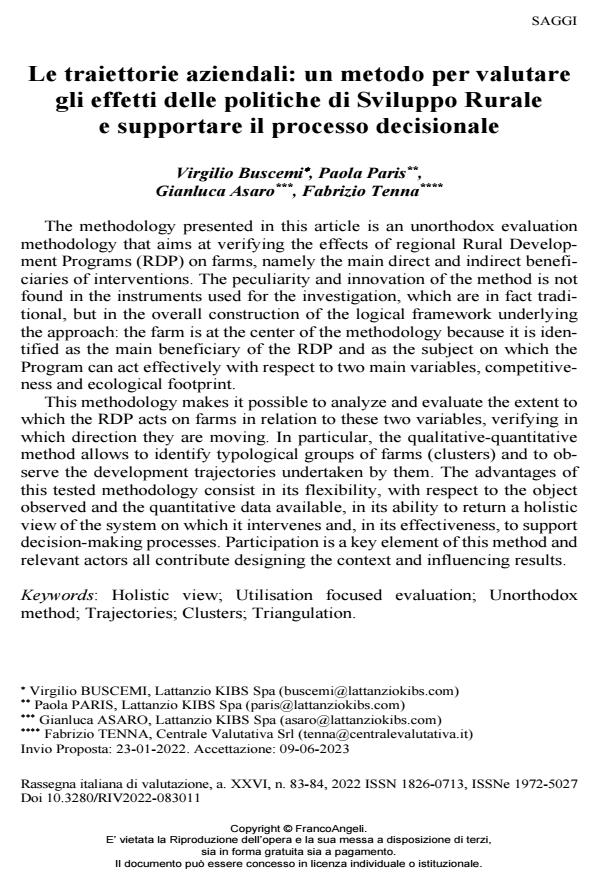Le traiettorie aziendali: un metodo per valutare gli effetti delle politiche di Sviluppo Rurale e supportare il processo decisionale
Titolo Rivista RIV Rassegna Italiana di Valutazione
Autori/Curatori Virgilio Buscemi, Paola Paris, Gianluca Asaro, Fabrizio Tenna
Anno di pubblicazione 2023 Fascicolo 2022/83-84
Lingua Italiano Numero pagine 25 P. 199-223 Dimensione file 388 KB
DOI 10.3280/RIV2022-083010
Il DOI è il codice a barre della proprietà intellettuale: per saperne di più
clicca qui
Qui sotto puoi vedere in anteprima la prima pagina di questo articolo.
Se questo articolo ti interessa, lo puoi acquistare (e scaricare in formato pdf) seguendo le facili indicazioni per acquistare il download credit. Acquista Download Credits per scaricare questo Articolo in formato PDF

FrancoAngeli è membro della Publishers International Linking Association, Inc (PILA)associazione indipendente e non profit per facilitare (attraverso i servizi tecnologici implementati da CrossRef.org) l’accesso degli studiosi ai contenuti digitali nelle pubblicazioni professionali e scientifiche
The methodology presented in this article is an unorthodox evalua-tion methodology that aims at verifying the effects of regional Rural Development Programs (RDP) on farms, namely the main direct and indirect beneficiaries of interventions. The peculiarity and innovation of the method is not found in the instruments used for the investiga-tion, which are in fact traditional, but in the overall construction of the logical framework underlying the approach: the farm is at the center of the methodology because it is identified as the main beneficiary of the RDP and as the subject on which the Program can act effectively with respect to two main variables, competitiveness and ecological foot-print. This methodology makes it possible to analyze and evaluate the ex-tent to which the RDP acts on farms in relation to these two variables, verifying in which direction they are moving. In particular, the qualita-tive-quantitative method allows to identify typological groups of farms (clusters) and to observe the development trajectories undertaken by them. The advantages of this tested methodology consist in its flexibil-ity, with respect to the object observed and the quantitative data avail-able, in its ability to return a holistic view of the system on which it in-tervenes and, in its effectiveness, to support decision-making process-es. Participation is a key element of this method and relevant actors all contribute designing the context and influencing results.
Parole chiave:Holistic view; Utilisation focused evaluation; Unorthodox method; Trajectories; Clusters; Triangulation
Virgilio Buscemi, Paola Paris, Gianluca Asaro, Fabrizio Tenna, Le traiettorie aziendali: un metodo per valutare gli effetti delle politiche di Sviluppo Rurale e supportare il processo decisionale in "RIV Rassegna Italiana di Valutazione" 83-84/2022, pp 199-223, DOI: 10.3280/RIV2022-083010